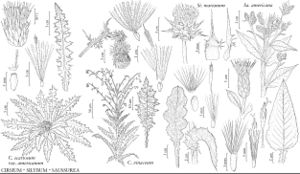Difference between revisions of "Silybum marianum"
Fruct. Sem. Pl. 2: 378. 1791.
FNA>Volume Importer |
imported>Volume Importer |
||
| (One intermediate revision by the same user not shown) | |||
| Line 8: | Line 8: | ||
}} | }} | ||
|common_names=Blessed milkthistle;chardon Marie | |common_names=Blessed milkthistle;chardon Marie | ||
| + | |special_status={{Treatment/ID/Special_status | ||
| + | |code=I | ||
| + | |label=Introduced | ||
| + | }}{{Treatment/ID/Special_status | ||
| + | |code=F | ||
| + | |label=Illustrated | ||
| + | }} | ||
|basionyms={{Treatment/ID/Basionym | |basionyms={{Treatment/ID/Basionym | ||
|name=Carduus marianus | |name=Carduus marianus | ||
| Line 30: | Line 37: | ||
|elevation=0–800 m | |elevation=0–800 m | ||
|distribution=Alta.;B.C.;N.B.;N.S.;Ont.;Que.;Sask.;Ala.;Ariz.;Ark.;Calif.;Conn.;Ind.;La.;Mich.;Miss.;Nev.;N.H.;N.J.;N.Mex.;N.Y.;N.C.;Ohio;Oreg.;Pa.;Tenn.;Tex.;Vt.;Va.;Wash.;W.Va.;s Europe (Mediterranean region). | |distribution=Alta.;B.C.;N.B.;N.S.;Ont.;Que.;Sask.;Ala.;Ariz.;Ark.;Calif.;Conn.;Ind.;La.;Mich.;Miss.;Nev.;N.H.;N.J.;N.Mex.;N.Y.;N.C.;Ohio;Oreg.;Pa.;Tenn.;Tex.;Vt.;Va.;Wash.;W.Va.;s Europe (Mediterranean region). | ||
| + | |introduced=true | ||
|discussion=<p><i>Silybum marianum</i> is sometimes cultivated as an ornamental, a minor vegetable, or as a medicinal herb. Young shoots can be boiled and eaten like cabbage and young leaves can be added to salads. The seeds can be used as a coffee substitute. Extracts of <i>S. marianum</i> are used as an herbal treatment for liver ailments.</p> | |discussion=<p><i>Silybum marianum</i> is sometimes cultivated as an ornamental, a minor vegetable, or as a medicinal herb. Young shoots can be boiled and eaten like cabbage and young leaves can be added to salads. The seeds can be used as a coffee substitute. Extracts of <i>S. marianum</i> are used as an herbal treatment for liver ailments.</p> | ||
|tables= | |tables= | ||
| Line 53: | Line 61: | ||
|publication title=Fruct. Sem. Pl. | |publication title=Fruct. Sem. Pl. | ||
|publication year=1791 | |publication year=1791 | ||
| − | |special status= | + | |special status=Introduced;Illustrated |
| − | |source xml=https:// | + | |source xml=https://bitbucket.org/aafc-mbb/fna-data-curation/src/2e0870ddd59836b60bcf96646a41e87ea5a5943a/coarse_grained_fna_xml/V19-20-21/V19_171.xml |
|tribe=Asteraceae tribe Cardueae | |tribe=Asteraceae tribe Cardueae | ||
|genus=Silybum | |genus=Silybum | ||
Latest revision as of 19:48, 5 November 2020
Stems glabrous or slightly tomentose. Leaves: basal wing-petioled, blades 15–60+ cm, margins coarsely lobed; cauline leaves clasping, progressively smaller and less divided, bases spiny, coiled, auriculate. Phyllary appendages spreading, ovate, 1–4 cm including long-tapered spine tips. Corollas 26–35 mm; tubes 13–25 mm, throats campanulate, 2–3 mm, lobes 5–9 mm. Cypselae brown and black spotted, 6–8 mm; pappus scales 15–20 mm. 2n = 34.
Phenology: Flowering Feb–Jun (west), Jul–Sep (north).
Habitat: Roadsides, pastures, waste areas, sometimes cultivated
Elevation: 0–800 m
Distribution

Introduced; Alta., B.C., N.B., N.S., Ont., Que., Sask., Ala., Ariz., Ark., Calif., Conn., Ind., La., Mich., Miss., Nev., N.H., N.J., N.Mex., N.Y., N.C., Ohio, Oreg., Pa., Tenn., Tex., Vt., Va., Wash., W.Va., s Europe (Mediterranean region).
Discussion
Silybum marianum is sometimes cultivated as an ornamental, a minor vegetable, or as a medicinal herb. Young shoots can be boiled and eaten like cabbage and young leaves can be added to salads. The seeds can be used as a coffee substitute. Extracts of S. marianum are used as an herbal treatment for liver ailments.
Selected References
None.
